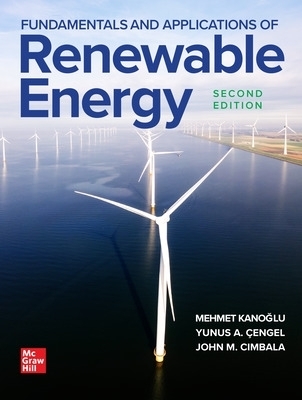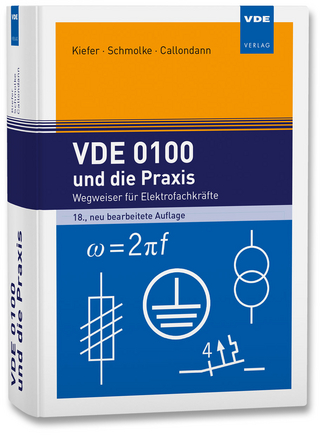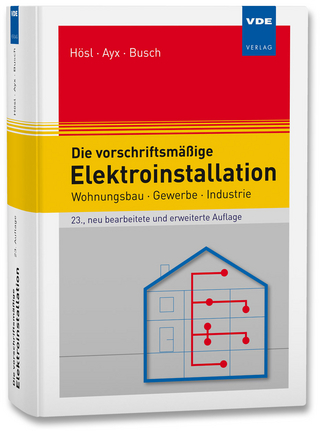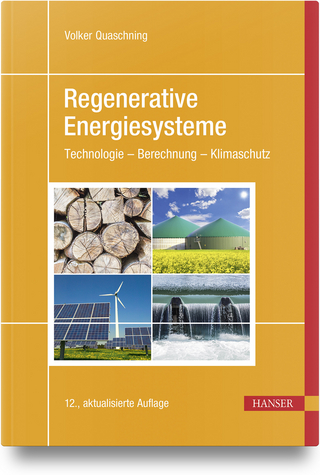
Fundamentals and Applications of Renewable Energy, Second Edition
McGraw-Hill Education (Verlag)
978-1-265-07965-9 (ISBN)
Written by a team of recognized experts, this thoroughly revised guide offers comprehensive coverage of all major renewable energy sources, including solar, wind, hydropower, geothermal, and biomass. This new edition keeps up to date with the rapid changes in renewable energy technology. Readers will get worked-out example problems and end-of-chapter review questions that help to reinforce important concepts.
By stressing real-world relevancy and practical uses, Fundamentals and Applications of Renewable Energy, Second Edition prepares students for a successful career in renewable energy. Readers will get detailed discussions on the thermodynamics, heat transfer, and fluid mechanics aspects of renewable energy systems as well as economic and environmental considerations. The book features new sections on solar thermal applications, photovoltaics, wind power and biomass energy.
Features both technical and economic analyses of renewable systems
Approximately 1100 end-of-chapter problems including conceptual and multiple-choice questions
Supplements include a complete PDF solutions manual and PowerPoint lecture slides
Written by a team of renewable energy educators and experienced authors
Yunus A. Çengel is Professor Emeritus of Mechanical Engineering at the University of Nevada, Reno. He received his B.S. in mechanical engineering from Istanbul Technical University and his M.S. and Ph.D. in mechanical engineering from North Carolina State University. His areas of interest are renewable energy, energy efficiency, energy policies, heat transfer enhancement, and engineering education. He served as the director of the Industrial Assessment Center (IAC) at the University of Nevada, Reno, from 1996 to 2000. He has led teams of engineering students to numerous manufacturing facilities in Northern Nevada and California to perform industrial assessments, and has prepared energy conservation, waste minimization, and productivity enhancement reports for them. He has also served as an advisor for various government organizations and corporations. Dr. Çengel is the recipient of several outstanding teacher awards, and he has received the ASEE Meriam/Wiley Distinguished Author Award for excellence in authorship in 1992 and again in 2000. Dr. Çengel is a registered Professional Engineer in the State of Nevada, and is a member of the American Society of Mechanical Engineers (ASME) and the American Society for Engineering Education (ASEE). John M. Cimbala is Professor of Mechanical Engineering at The Pennsylvania State University (Penn State), University Park, PA. He received his B.S. in Aerospace Engineering from Penn State and his M.S. in Aeronautics from the California Institute of Technology (CalTech). He received his Ph.D. in Aeronautics from CalTech in 1984. His research areas include experimental and computational fluid mechanics and heat transfer, turbulence, turbulence modeling, turbomachinery, indoor air quality, and air pollution control. More information can be found at www.mne.psu.edu/cimbala. Professor Cimbala is the recipient of several outstanding teaching awards and views his book writing as an extension of his love of teaching. He is a member and Fellow of the American Society of Mechanical Engineers (ASME). He is also a member of the American Society for Engineering Education (ASEE), and the American Physical Society (APS).
Preface
Chapter 1. Introduction to Renewable Energy
1-1 Why Renewable Energy?
1-2 Dimensions and Units
1-3 Fossil Fuels and Nuclear Energy
References
Problems
Chapter 2. A Review of Thermal Sciences
2-1 Thermal Sciences
2-2 Thermodynamics
2-3 Heat Transfer
2-4 Fluid Mechanics
2-5 Thermochemistry
2-6 Heat Engines and Power Plants
2-7 Refrigerators and Heat Pumps
References
Problems
Chapter 3. Fundamentals of Solar Energy
3-1 Introduction
3-2 Radiation Fundamentals
3-3 Radiative Properties
3-4 Solar Radiation
3-5 Estimation of Solar Radiation
References
Problems
Chapter 4. Solar Energy Applications
4-1 Introduction
4-2 Flat-Plate Solar Collector
4-3 Evacuated Tube Collectors
4-4 Concentrating Solar Collector
4-5 Solar-Power-Tower Plant
4-6 Solar Pond
4-7 Passive Solar Applications
References
Problems
Chapter 5. Solar Photovoltaic Systems
5-1 Photovoltaic Effect
5-2 Analysis of Solar Cells
5-3 Photovoltaic Technologies and Systems
5-4 Energy Production from Photovoltaic Systems
5-5 Photovoltaic System Configurations
5-6 Components of Photovoltaic Power Systems
References
Problems
Chapter 6. Wind Energy
6-1 Introduction
6-2 Wind Turbine Types and Power Performance Curve
6-3 Wind Turbine Operation and Aerodynamics
6-4 Wind Power Potential
6-5 Wind Power Density
6-6 Wind Turbine Efficiency
6-7 Electricity Production from Wind Turbines
6-8 Wind Power Costing
6-9 Considerations in Wind Power Applications
References
Problems
Chapter 7. Hydropower
7-1 Introduction
7-2 Analysis of a Hydroelectric Power Plant
7-3 Impulse Turbines
7-4 Reaction Turbines
7-5 Turbine Specific Speed
7-6 Run-of-River Plants and Waterwheels
References
Problems
Chapter 8. Geothermal Energy
8-1 Introduction
8-2 Geothermal Applications
8-3 Geothermal Heating
8-4 Geothermal Cooling
8-5 Geothermal Heat Pump Systems
8-6 Geothermal Power Production
8-7 Geothermal Cogeneration
References
Problems
Chapter 9. Biomass Energy
9-1 Biomass Resources
9-2 Conversion of Biomass to Biofuel
9-3 Anaerobic Digestion
9-4 Thermal Gasification
9-5 Ethanol
9-6 Biodiesel
9-7 Liquid Fuels from Syngas, Pyrolysis Oil, and Biocrude
9-8 Electricity and Heat Production by Biomass
9-9 Municipal Solid Waste
References
Problems
Chapter 10. Ocean Energy
10-1 Introduction
10-2 Ocean Thermal Energy Conversion
10-3 Wave Energy
10-4 Tidal Energy
References
Problems
Chapter 11. Hydrogen and Fuel Cells
11-1 Hydrogen: An Energy Carrier
11-2 Fuel Cells
References
Problems
Chapter 12. Economics of Renewable Energy
12-1 Engineering Economics
12-2 The Time Value of Money
12-3 Life Cycle Cost Analysis
12-4 Payback Period Analysis
References
Problems
Chapter 13. Energy and the Environment
13-1 Introduction
13-2 Air Pollutants
13-3 Emissions from Automobiles
13-4 The Greenhouse Effect
13-5 Stratospheric Ozone Depletion
13-6 Nuclear Waste
References
Problems
Appendix 1. Property Tables (SI Units)
Appendix 2. Property Tables (English Units)
Index
| Erscheinungsdatum | 22.07.2023 |
|---|---|
| Zusatzinfo | 225 Illustrations |
| Verlagsort | OH |
| Sprache | englisch |
| Gewicht | 1114 g |
| Themenwelt | Technik ► Elektrotechnik / Energietechnik |
| Technik ► Umwelttechnik / Biotechnologie | |
| ISBN-10 | 1-265-07965-X / 126507965X |
| ISBN-13 | 978-1-265-07965-9 / 9781265079659 |
| Zustand | Neuware |
| Informationen gemäß Produktsicherheitsverordnung (GPSR) | |
| Haben Sie eine Frage zum Produkt? |
aus dem Bereich


